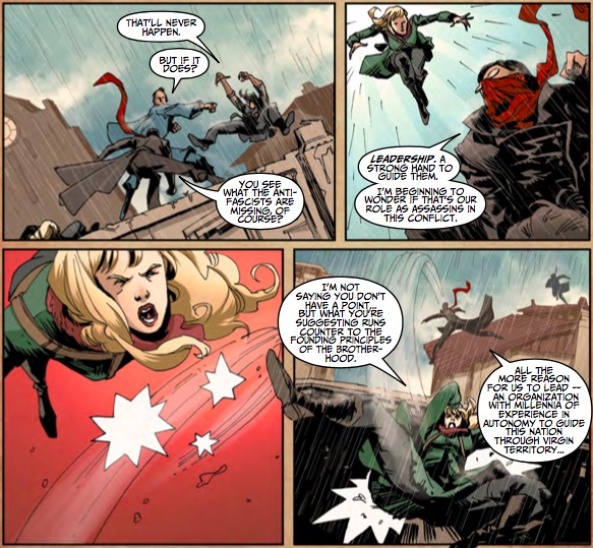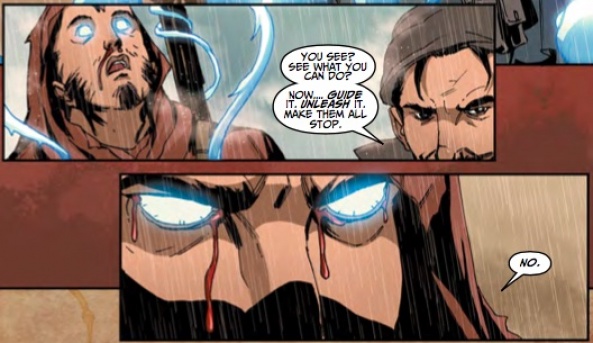With the end of “Assassin’s Creed: Reflections” last month, this month’s Isu Codices will delve into only “Assassin’s Creed: Uprising.”
New Concepts
Romance

Couples amongst the Assassins have been seen at various times, though less commonly than Assassins marrying outside of the Brotherhood. In the Victorian Age, the British Dame Evie Frye fell in love with Indian Assassin Jayadeep Mir, a.k.a. Sir Henry Green, and seemed to still be together with him twenty years after his proposal. By the late 20th century, William Miles and his own wife, both members of the global Assassin Brotherhood, had a son named Desmond. Most recently, Arend Schut married Harlan Cunningham, both of them being members of the underground Brotherhood of the 21st century.
Though unlikely, the star-crossed lovers dynamic of a romance between an Assassin and a Templar is not unheard of. As early as the late 12th and early 13th centuries, Levantine Assassin Mentor Altaïr Ibn-La’Ahad married Levantine Templar Maria Thorpe. Centuries later, during the French Revolution of the late 18th century, Paris was host to Assassin Arno Dorian’s shared love with Templar Élise de la Serre, to the eventual doom of them both.
Far more common seems to be the idea of a relationship outside of the conflict altogether. From Ezio Auditore da Firenze and Edward Kenway on the Assassin side to Juhani Otso Berg on the Templar side, the more stable (though at times still dangerous) relationships seem to be those divorced from the war altogether, though it can ultimately lead people to become part of it nonetheless.
Methodological Differences

The Assassin Brotherhood tends to assign a single person to a mission. The more competent members seems to be fully capable of fulfilling an objective without any additional Assassins coming in, enough that these people actually gather more members to their cause by their sheer effectiveness in saving others from oppression. For higher-ranking members, especially leaders and/or Mentors from a particular branch of the Brotherhood, a group of Assassins are somewhat more common, around three or four.
On the other hand, the Templars seem to act in groups, supported by armies. They are more likely to throw a group of less trained people at a foe, only fighting back personally when absolutely necessary or sure they have enough of an upper hand.
This difference can be seen most easily when it comes to Haythem Kenway’s trip to the Americas in 1754. While he used elements of stealth in dealing with an Assassin at one point, Kenway opted to bring a group of men with him over going completely alone. This is contrasted with the Assassin sent to kill him en route to the “new world,” Louis Mills, who is never with another member of the Brotherhood and utilizes his stealth far more than social and monetary advantages, only revealing his identity when making his attempt to assassinate Kenway in the first place.
This mentality is important in establishing an outsider as a member of the Assassins in this month’s “Assassin’s Creed: Uprising.” Nobby Clarke came from London and gets on the good side of the Spanish Assassins by noting his personal, solo annihilation of the Templar cell in Tallinn, Estonia. While this level of destruction is uncommon, it isn’t entirely unlikely for an Assassin, and so is actually enough to get him into the branch’s good graces despite a rocky start.
Continued belowDesynchronization

Charlotte de la Cruz is the most common sufferer of desynchronization, for one reason or another. Not only does she experience a bad headache, but she also has extreme nausea, to the point of, on at least two occasions, actually vomiting immediately after exiting to her modern era.
However, her own reasons for desynchronization are not solely related to avoiding the way forward set by her ancestors or even dying. Instead, her time in the Grey and exchange of memories with Juno seems to have corrupted her, making proper use of the Animus difficult and dangerous. Dutch Assassin Arend Schut Cunningham identifies at least part of Charlotte’s condition as similar to the idea that her “parietal lobes have been digitally bashed together.” The parietal lobe of the brain is most commonly associated with such tasks as language processing, spatial sense, navigation, and touch, in addition to other responsibilities.
Could her difficulties be as dangerous as, or even more dangerous than the infamous Bleeding Effect? Only time can tell how badly she will be hurt, inside and out.
New Issues
Assassin’s Creed: Uprising #6
As in many times of war, the Spanish Assassins of the late 1930s were naturally skeptical about people who allegedly come to their aid. Judging from the dynamic of the cell Ignacio Cardona hailed from, they seem to have worked as a collective entity of approximately four people, though each of their ultimate specialties remains uncertain, compared to other Assassin cells like that of William Miles in 2012. A relatively minor detail seems to be the apparent romance between Ignacio and his fellow Assassin, Glaucia Acosta.
The arrival of Nobby Clarke and the reactions to said arrival indicate that, much like the networks stretching back as far as the Renaissance, if not earlier, the different Assassin branches had a kind of communication network between them, with the Spanish calling the British for help. The exact size of the British Brotherhood in that era is uncertain, but given that Ignacio is so upset about not getting a dozen of them, the British Assassins likely have a significantly larger force than the Spanish.
When Charlotte desynchronizes, her nausea again comes to the surface, with her vomiting right on the Animus instantly after being thrust out of the system. She seems to be determined to keep going, but it’s unclear how much more she can keep at this with her mind still adversely affected by the antagonistic Isu Juno.

The Assassins’ practices of keeping secrets from one another are not kept to the mid-2010s alone. Back in the Spanish Civil War, different members of the Spanish Assassins were undecided on which group in the “anti-fascists” they should ally themselves toward, between the anarchists and the communists. Dwight believed in working with the anarchists to create something new, while Miguel Carasso instead thought that the appropriate action was to ally with the government through the Communists as a more heavily armed and well-stocked option.
Continued below


Speaking of saving a life, the violent rejection from the Koh-i-Noor seems to have had a volatile effect on Charlotte, who is biting her own tongue nearly off in what appears to be a seizure, spitting blood all the while. My’shell Lamarr seems to be her only hope to survive, and if Arend doesn’t let her through to do so, she is likely to be forever lost in the simulation much like Clay Kaczmarek and very nearly Desmond Miles, if not just killed outright.
Judging from the solicitation for the seventh issue (likely to come September 6) at the end of this one, Charlotte’s deteriorating condition won’t allow her another trip in the Animus, at least not anytime soon. Instead, Otso Berg himself seems to be prepared to take the plunge, and perhaps finally discover what really happened to Albert Bolden after that fateful night in Shanghai of 1927.






